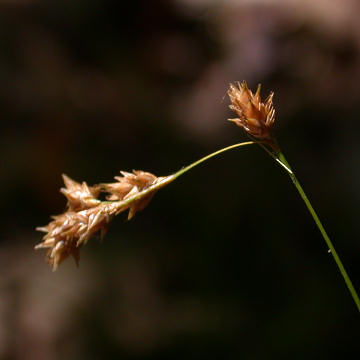

Carex foenea - (image 1 of 5)
Taxonomy
Family: Cyperaceae
Section Ovales
Habitat
Wet to dry areas.
Associates
Distribution
Labrador and Newfoundland to Yukon and British Columbia, south to CT, NY, PA, MI, and ID.
Morphology
Tufted perennial to 1 m; aphyllopodic. Leaves 3-5 mm wide, shorter than stems, bracts inconspicuous. Spikes 3-15, gynaecandrous, 6-25 mm, sessile in a loose, often lax spike that is sometimes interrupted below. Pistillate scales equally but narrower than perigynia; perigynia planoconvex, smooth, to 5 mm long and 2.2 mm wide, nerveless or few nerved ventrally, strong 3-8 nerved dorsally, widest below, beak flattened and sometimes obscure; margin winged, the wings finely serrulate-ciliolate, not expanded above the middle. Achene lenticular, 1.5-2 mm; stigmas 2.
Notes
Fruiting late spring to early summer
Wetland indicator: UPL
The specific epithet means "hay", perhaps referring to the color of the spikes at maturity. Carex argyrantha is similar but strongly 5-8 nerved on the ventral side of the perigynium. The USDA lumps this species with Carex siccata, but according to several sources it is a clearly distinct species with long-creeping rhizomes.
References
Gleason, Henry A. and A. Cronquist. 1991. Manual of Vascular Plants of
Northeastern United States and Adjacent Canada. Second Ed.
The New York Botanical Garden. Bronx, NY
Swink, F. and G. Wilhelm. 1994. Plants of the Chicago Region.
Indiana Academy of Science. The Morton Arboretum. Lisle, Illinois.
|
© Michael Hough 2010 |